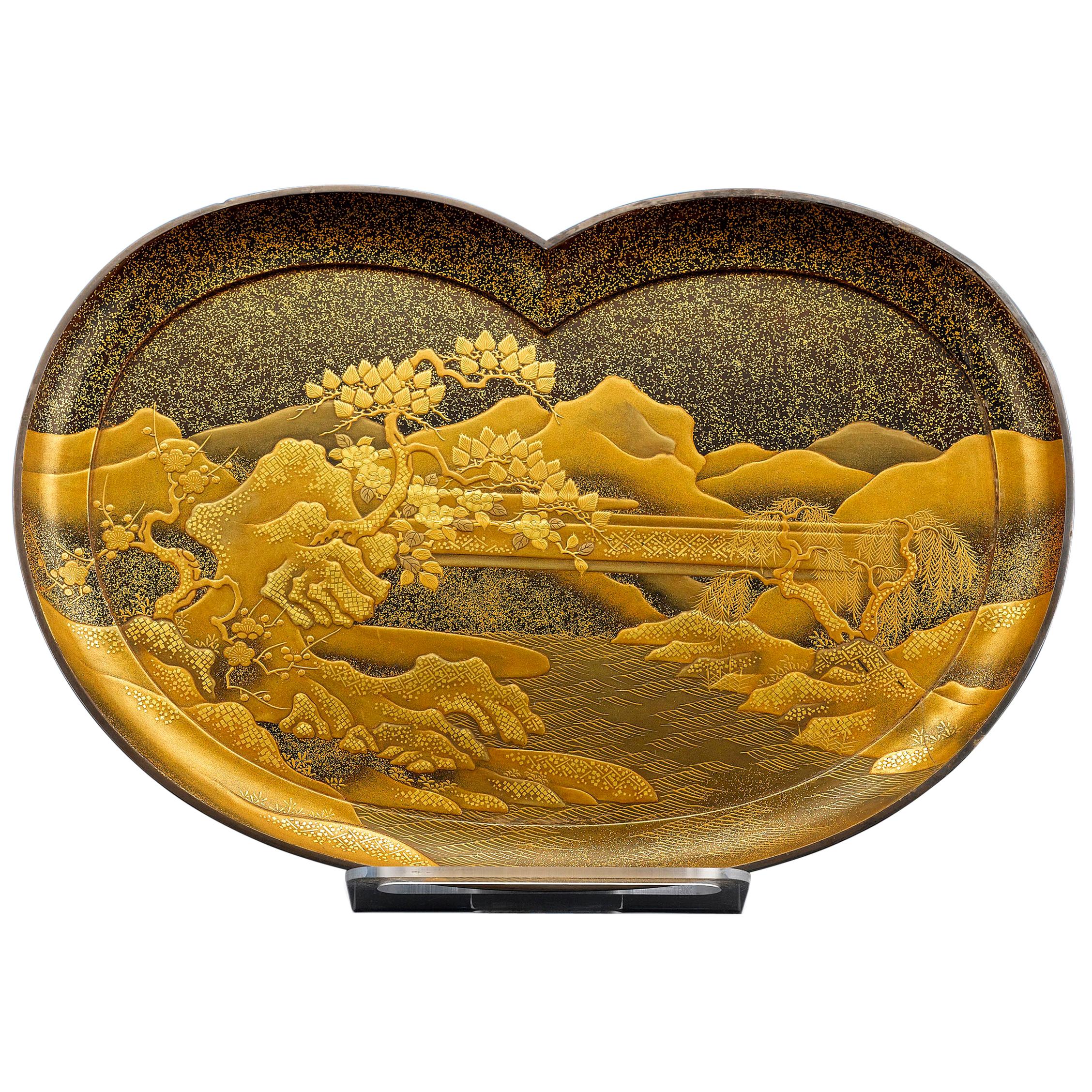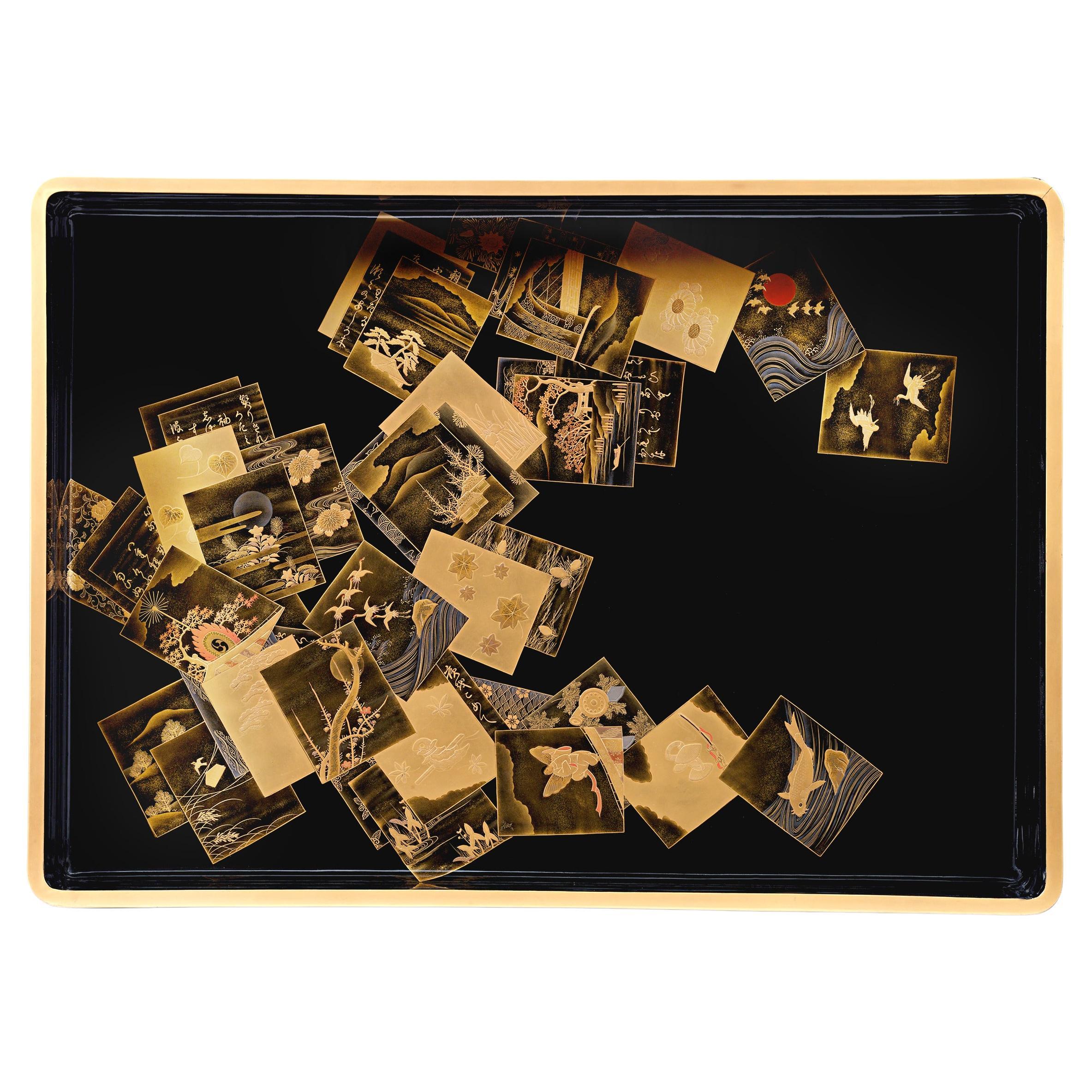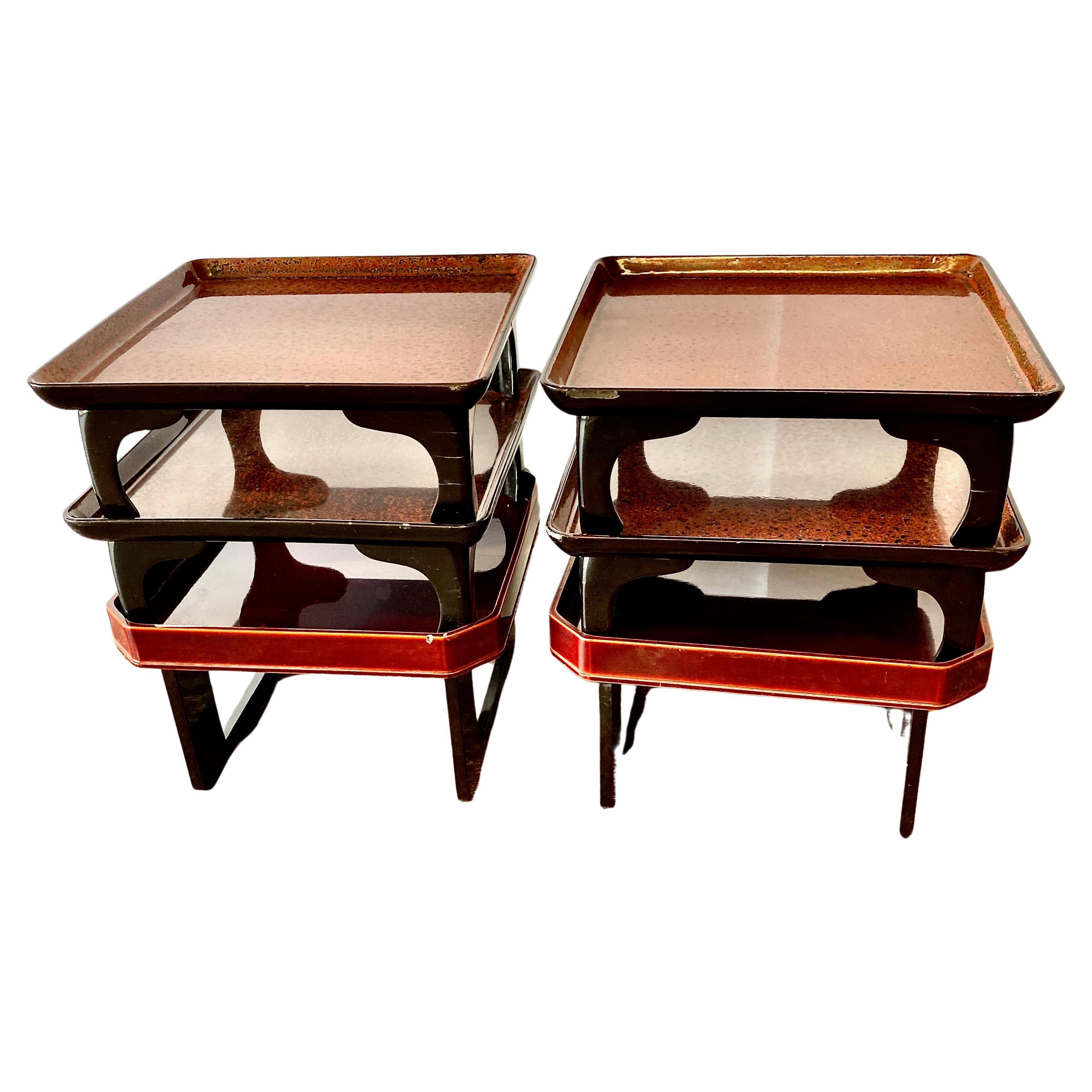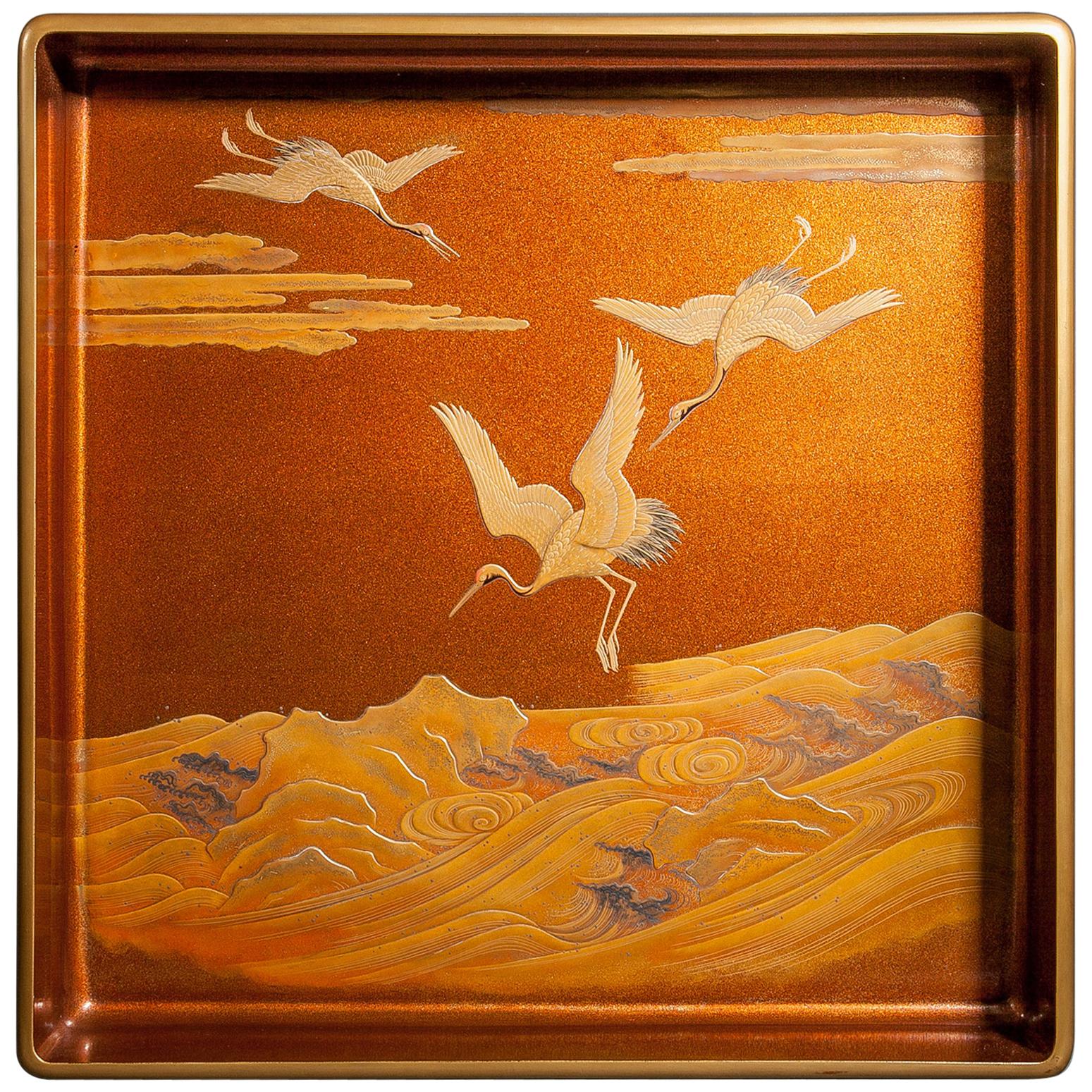Want more images or videos?
Request additional images or videos from the seller
1 of 6
Japanese Lacquer and Gold Tray
About the Item
This Meiji-period lacquer tray represents the mastery of Japanese craftsmen in the art of lacquer work. Precious materials are precisely inlaid in the lacquer base, creating a highly illusionistic three-dimensional effect. Gold lacquer borders the intricately laid design, which features romantic maki-e floral motifs executed in gold and other natural materials. The all-over design highlights the bounty of the natural world.
The creation of a lacquer tray such as this would have been an incredibly time-consuming process; the art form is considered among the most labor intensive in the world and requires an exceptional level of finesse. Intricately detailed lacquer trays such as this reveal the mastery of their maker.
The tray comes set in its original box.
Late 19th century
3 3/4" high x 23 3/4" wide x 23 3/4" high.
- Dimensions:Height: 3.75 in (9.53 cm)Width: 23.75 in (60.33 cm)Depth: 23.75 in (60.33 cm)
- Style:Meiji (Of the Period)
- Materials and Techniques:
- Place of Origin:
- Period:
- Date of Manufacture:Late 19th Century
- Condition:
- Seller Location:New Orleans, LA
- Reference Number:
About the Seller
5.0
Recognized Seller
These prestigious sellers are industry leaders and represent the highest echelon for item quality and design.
Established in 1912
1stDibs seller since 2010
93 sales on 1stDibs
Typical response time: 7 hours
- ShippingRetrieving quote...Ships From: New Orleans, LA
- Return PolicyA return for this item may be initiated within 7 days of delivery.
More From This SellerView All
- Japanese Lacquer TrayLocated in New Orleans, LAAs beautiful as it is practical, this Japanese Meiji-period lacquered tray is distinguished by its exceptional craftsmanship. It exhibits a phenomenal artistry as the entire tray is ...Category
Early 20th Century Japanese Meiji Lacquer
MaterialsLacquer
- Japanese Lacquer TrayLocated in New Orleans, LAHailing from illustrious Meiji-period Japan, this lacquer tray showcases the mastery of Japanese craftsmen. Precious materials are precisely inlaid in the lacquer base, creating an a...Category
Antique Late 19th Century Japanese Meiji Lacquer
MaterialsSilver
- Japanese Lacquer Tray With CardsLocated in New Orleans, LAThis Meiji-period lacquer tray represents the mastery of Japanese craftsmen in the art of lacquer work. Precious materials are precisely inlaid in the lacquer base, creating a highly...Category
Antique Late 19th Century Japanese Meiji Lacquer
MaterialsGold
- Japanese Lacquer BoxLocated in New Orleans, LAThis exquisite Meiji-period lacquer document box known as a ryoshibako showcases the meticulous artistry of maki-e, a technique of raised lacquer decoration. Adorned with gold and vi...Category
Antique 19th Century Asian Meiji Lacquer
MaterialsGold
- Chinese Cinnabar Lacquer CuspidorLocated in New Orleans, LAThis intriguing Chinese zhadou is intricately carved of fine cinnabar lacquer. A work of exceptional artistry, this covered bowl is adorned with an intricately carved floral motif on all surfaces, including the cover and the wide rim. Also known as a cuspidor or spittoon, this rare container would have been used by members of the imperial family and scholar- officials at the court. Carved during the Kangxi period (1662-1722), this charming piece exhibits the high detail and charm associated with items from that period, making it a true treasure, Early 18th century (Kangxi dynasty) Measures: 6 ¼” wide x 3 ¼” high Cinnabar has been revered for its color all over the world. It has been found in the royal burial chambers of the Mayas, in the rituals of India, and in the ruins of ancient Greece and Rome. In China, cinnabar and gold were the two most important elements in alchemy. Mined since the Neolithic Age, cinnabar is the ore of mercury, and as such, it can be incredibly toxic, especially when mining. In fact, during the Roman Empire, miners at Spain’s Almadén mine in Spain were frequently exposed to mercury fumes, and the subsequent, often fatal, sickness was considered an occupational hazard. The most popular known use of cinnabar is in Chinese carved lacquer-ware, a technique that is believed to have originated in the Song Dynasty, in which cinnabar is ground to a powder and added to clear lacquer. As with mining, there was inherent danger of mercury poisoning for those who carved the lacquer, as mercury was also released into the air when artisans ground the pigments. Most antique cinnabar...Category
Antique 18th Century Chinese Other Lacquer
MaterialsLacquer
- Edo-Period Lacquered JingasaLocated in New Orleans, LAComplete with a lacquered surface and original silk straps, this Japanese Edo-period traveling hat, or jingasa, first emerged during the illustrious period between 1603 and 1868, a t...Category
Antique 19th Century Asian Edo Lacquer
MaterialsSilk
You May Also Like
- Japanese Lacquer TraysLocated in Pasadena, CAThis is a wonderful collection of 6 mid-20th century Japanese Lacquer Trays. There is one pair of oxblood red with highlights; one pair of matched oil spot trays and one near pair of...Category
Mid-20th Century Japanese Lacquer
MaterialsWood, Lacquer
- Japanese Lacquer and Geometric Meiji Period Inlaid TrayLocated in Garnerville, NYJapanese inlaid, lacquered and gilded tray. Possibly for the sacred tea ceremony. This tray has beautiful geometric inlays with a gilded edge and a bla...Category
Antique 1890s Japanese Meiji Lacquer
MaterialsWood, Fruitwood, Oak, Lacquer
- Japanese Nashiji Lacquer Tray with Crane and Wave DesignLocated in Hudson, NYJapanese Nashiji lacquer tray with crane and wave design, this exquisite tray is a masterful example of multiple lacquer techniques using gold (including maki-e and takamaki-e). This...Category
Antique Late 19th Century Japanese Meiji Lacquer
MaterialsGold
- Japanese Lacquer Tray with Intricate DesignsLocated in Hudson, NYThis lacquer tray uses several lacquer techniques including multi-color painting of flowers, ito-me (thread pattern) and shell inlay. The artist was Shimano Sanshu (1877 - 1965). He ...Category
Early 20th Century Japanese Showa Lacquer
MaterialsLacquer
- An Antique Japanese Lacquer Maki-e TrayLocated in Atlanta, GAA fan shape black lacquer tray from Japan circa 1910-30s, late Meiji to early Showa era. Elaborated decorated with a bundle of yomogi blossom in a very fine Maki-e technique using both gold and silver powders. There is a Japanese symbol on the top left, which represents yomogiu, stemming from yomogi (蓬), a wild plant that belongs to the chrysanthemum family and widely grown in Japan. This name yomogui is from a scene in the Tale of Genji...Category
Early 20th Century Japanese Japonisme Lacquer
MaterialsLacquer
- Pair of Antique Japanese Lacquer TraysLocated in Hudson, NYPair of antique Japanese Lacquer Trays, Taisho period (1912-1926) beautifully decorated with a miniature landscape of pea pods on the vine and a gold cricket set...Category
Vintage 1920s Japanese Taisho Lacquer
MaterialsLacquer
Recently Viewed
View AllMore Ways To Browse
Japanese Lacquer Bento Box
Japanese Lacquer Coffer
Lacquered Bento Box
Vintage Japanese Lacquer Tray
Antique Japanese Bento Box
Bento Box Vintage
Sofu Teshigahara
Vintage Wooden Paper Tray
Japanese Ojime
Lac Burgaute
Vintage Japanese Bento Box
Antique Quran Stand
Japanese Hokkai Box
Straits Altar
Japanese Bento
Japanese Makie Lacquer
Japanese Wall Mother Of Pearl
Makie Lacquer





